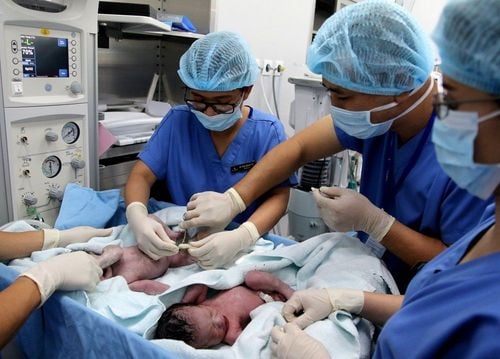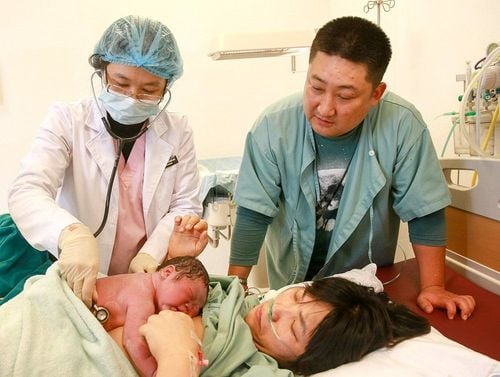This is an automatically translated article.
The article was professionally consulted by Doctor Department of Obstetrics and Gynecology - Vinmec Hai Phong International General Hospital.
Breast milk is a valuable source of nutrition and is the best food for infants and children, helping to bond mother and child. Therefore, not having enough milk for breastfeeding is always a fear of mothers after giving birth, especially for mothers who give birth by caesarean section and do not have milk right away like mothers who give birth naturally.
1. When does the mother have to have a cesarean section?
The mother is indicated for a cesarean section in the following cases:
On the mother's side: The mother has an abnormal pelvis, placenta previa, anterior tumor that obstructs the outflow of the fetus; the mother's health is not guaranteed; mother has cardiovascular disease, infectious disease; have had multiple pregnancies at once and have had multiple previous cesarean deliveries or had uterine surgery. On the side of the fetus: The fetus is not in the right position near the date of birth, acute fetal distress; The baby is too big.
Trắc nghiệm: Bạn có hiểu đúng về dấu hiệu mang thai sớm?
Các dấu hiệu mang thai sớm không phải chỉ mỗi trễ kinh mà còn có rất nhiều dấu hiệu khác như xuất huyết âm đạo, ngực căng tức,… Điểm xem bạn biết được bao nhiêu dấu hiệu mang thai sớm thông qua bài trắc nghiệm này nhé!
2. Advantages and disadvantages of caesarean section
Advantages of cesarean section:
The mother does not lose strength and is completely awake. Caesarean section makes the baby safer because less accidents happen. In case the fetus is in a dangerous condition, it is possible to remove the baby from the mother's body very quickly. Cons of cesarean section:
Complications during anesthesia, anesthesia for mother and baby. Mother has skin scars, causing cosmetic loss. The postoperative period is prolonged and causes more blood loss. The health of pregnant women takes longer to recover. The mother's inability to breastfeed in the first few hours after birth affects the secretion of the milk glands and makes the mother having a caesarean section without milk for the first few days after birth. Can cause the uterus to become red, easy to lead to intestinal adhesions, cystitis, surgical site infection ... Babies born by cesarean section are more susceptible to infections and allergies than babies born vaginally because they are not exposed to bacteria in the vaginal delivery.

3. Why does a cesarean mother not have milk right away?
When giving birth by cesarean section, the mother has to undergo a surgery that lasts about 1 hour. The mother will feel no pain during the surgery, but still know what the doctors are doing to her body and can still hear the baby crying when it is born. In other words, the mother will be prescribed an anesthetic, in some other special cases, an anesthetic will be used. However, the most common problem in women after cesarean section is not having milk right away, which makes mothers very worried. Accordingly, the reasons why mothers cannot produce milk after cesarean section are as follows:
Difficulty in producing milk after cesarean section due to drugs: Anesthesia and anesthetics used during surgery affect the mother's ability to produce milk. . Anti-infective and anti-inflammatory antibiotics given to mothers after surgery will inhibit milk production hormones and lead to loss of milk after cesarean section. Difficulty in producing milk after cesarean section due to not breastfeeding immediately: Mothers cannot breastfeed immediately after giving birth but have to wait about 2 hours after surgery. Besides, the mother cannot perform skin-to-skin contact with the baby right after the baby is born, so the milk glands are not stimulated. Improper breastfeeding: For mothers who have had a caesarean section and have a vaginal birth, if they breastfeed incorrectly or give their babies formula instead of breast-feeding right after birth, the possibility of having difficulty producing milk after birth is very high. Effects from incision: After cesarean section and vaginal birth, mothers often experience constipation. In addition, the pain in the incision and perineum makes it difficult for the mother to eat and drink, and the body does not have enough nutrients to produce milk for the baby. The mother had trouble sleeping, insomnia, and her lifestyle was turned upside down due to pain. In addition, complications after surgery will have a very high risk of losing milk after giving birth.
4. How to get milk fast after caesarean section
Caesarean without milk often takes place at many different times, maybe right after giving birth a few days or a whole month. At that time, most mothers were very worried because they did not know if they could regain their milk if they lost their milk. However, mothers can rest assured that mothers can call milk back quickly with some notes after cesarean section as follows:
Breastfeeding: Breastfeed as much as possible, pay attention to your baby's feeding position to ensure that the baby is able to suckle a lot of milk, comfortably, and the mother does not have nipple pain.

A cesarean delivery without milk usually takes place at different times, possibly a few days or a month after birth. At that time, most mothers were very worried because they did not know if they could regain their milk if they lost their milk. However, mothers can rest assured that mothers can call milk back quickly with some notes after cesarean section as follows:
Breastfeeding: Breastfeed as much as possible, pay attention to your baby's feeding position to ensure that the baby can suckle more milk, comfortably, and the mother does not have nipple pain. Maintain a scientific diet: For cesarean births and vaginal births, in order to produce more milk, the mother needs to maintain a scientific diet. The mother's daily diet needs 200 grams of meat, fish, eggs, 1 liter of fresh milk or powdered milk, 200-300 grams of fruit, 500 grams of vegetables. According to folklore, there are some foods to improve breast milk such as: Pork leg or goat leg stewed with papaya, pork leg porridge stewed with black beans, red beans, lettuce seeds, black sesame porridge, sweet potato leaves,... Massage and warm the breasts: Massage the breasts in a circular motion, from the inside out to the nipple. You can also use a soft towel dipped in hot water, wring it out and apply a warm compress to the breast. The mother's breast massage or gently wipe the breast with a warm towel not only helps the milk flow more easily, but also helps the baby latch on to the breast properly and help the baby receive the necessary amount of milk. Drink plenty of warm water: This is an important factor to ensure the “milk factory” has enough water. Types of tea leaves, buds, and roasted rice water are also folk experiences that are applied quite commonly and bring high efficiency. Mental comfort: No stress is a medicine to help mothers have more milk. Mother should rest properly, avoid negative negative thoughts, mentally stable and cheerful. Mothers can take advantage of the free time during the day to listen to music, watch movies, read newspapers, ... keep a comfortable mental state, help milk production quickly. Women should also note the following after giving birth: after giving birth for a few days, if the mother still has no milk or too little milk, please consult a doctor. The doctor can conduct tests to see if there are any factors that interfere with the production of breast milk to promptly provide the best solution.
To register for examination and treatment at Vinmec International General Hospital, you can contact the nationwide Vinmec Health System Hotline, or register online HERE.













